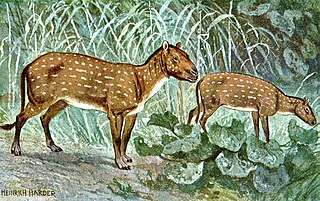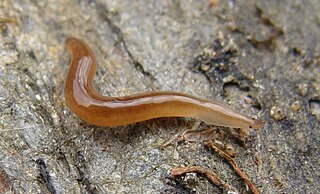
Selaginella is the sole genus of vascular plants in the family Selaginellaceae, the spikemosses or lesser clubmosses.

Protopterus is the genus of four species of lungfish found in Africa. Protopterus was formerly thought to be the sole genus in the family Protopteridae, but more recent studies have classified it with Lepidosiren in the family Lepidosirenidae.
Auricle is an Anglicization of Latin auricula, from auris 'ear' and -cula, a diminutive suffix.

Eohippus is an extinct genus of small equid ungulates. The only species is E. angustidens, which was long considered a species of Hyracotherium. Its remains have been identified in North America and date to the Early Eocene (Ypresian) stage.

Microcachrys tetragona, the creeping pine or creeping strawberry pine, is a species of dioecious conifer belonging to the podocarp family (Podocarpaceae). It is the sole species of the genus Microcachrys. The plant is endemic to western Tasmania, where it is a low shrub growing to 1 m tall at high altitudes. Its leaves are scale-like, arranged in opposite decussate pairs, superficially resembling those of the unrelated Diselma archeri (Cupressaceae). It shares the common name Creeping pine with several other plants. Females produce tiny, red, edible berries in summer.

The creeping vole, sometimes known as the Oregon meadow mouse, is a small rodent in the family Cricetidae. Ranging across the Pacific Northwest of North America, it is found in forests, grasslands, woodlands, and chaparral environments. The small-tailed, furry, brownish-gray mammal was first described in the scientific literature in 1839, from a specimen collected near the mouth of the Columbia River. The smallest vole in its range, it weighs around 19 g (0.67 oz). At birth, they weigh 1.6 g (0.056 oz), are naked, pink, unable to open their eyes, and the ear flaps completely cover the ear openings. Although not always common throughout their range, there are no major concerns for their survival as a species.

Platydemus is a genus of large predatory land planarians in the tribe Rhynchodemini.
Persoonia moscalii, commonly known as the creeping geebung, is a shrub native to southwestern Tasmania.

The reproductive system of planarians is broadly similar among different families, although the associated structures can vary in complexity.

Pasipha is a genus of land planarians from South America.

Xerapoa is a genus of land planarians from Brazil.

Australoplana also known as Australian flatworm is a genus of land planarians from Australia and New Zealand.
Tasmanoplana is a genus of land planarians from Australia.
Reomkago is a genus of land planarians from Australia.

Fletchamia is a genus of land planarians from Australia.
Lenkunya is a genus of land planarians from Australia.

Rhynchodemus is a genus of land planarians in the tribe Rhynchodemini.

Dolichoplana is a genus of land planarians in the tribe Rhynchodemini.

Coeloplana astericola, the creeping comb jelly, is a species of benthic comb jelly from the tropical western Indo-Pacific region that lives as an episymbiont on starfish such as Echinaster luzonicus.

Protea repens, known as the common sugarbush and in Afrikaans as the suikerbossie, is an erect shrub growing in the southern regions of South Africa. Related to other proteas, this plant is a relatively adaptable and variable species and can be found growing widely in various soils. Due to its showy flowers and adaptability, it is a popular garden subject for use in wildlife gardens in South Africa.














